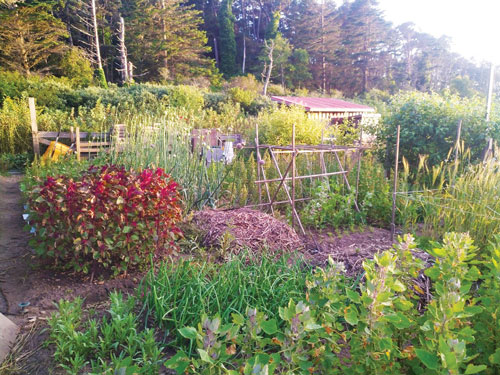The Victory Gardens for Peace Mini-Farm Report
At this point in the winter, on a good year, I am eager to see the garden dry out a bit. Our heavy wet clays and location down slope from some steep hillsides causes us to f lood for most of the winter. It’s always a challenge to get cover crops established early, but not too early, so that a microclimate can fill in and protect our soil from the f looding. In the last 100 years, prior to our garden, the topsoil had been removed from this site three times, and occasionally graded to improve drainage (the original Highway 1 was a gravel road that came right through the garden). For much of the 2nd half of the 1900’s it was overgrazed with sheep, lamas, and most recently horses, until all that would grow was buttercup, a plant toxic to animals. I haven’t seen many gardens that have been grown successfully after such abuse to the soil. But the sad reality is that many soils around the world have seen this kind of misuse. And as a counterpoint to that, it is amazing to see people all over the world using GROW BIOINTENSIVE® to reclaim lost soils and bring them back to life. It’s some of the most heartening experiences to watch people all over the world grow food and soil in a harmonious way. These farmers and gardeners carry on the timeless traditions of doing work by hand, without noisy, polluting machines, and synthetic sprays and powders. It’s good to know that with a garden spade, some seeds, a watering can, and some homegrown compost, we can get back on the right foot. A gentleman walked by our mini-farm last year and caught my attention saying, “Hey! You’re a real-dirt farmer!’ What greater compliment! I thanked him and offered him some seeds. He came up to the seed bank, we talked about his garden, I gave him some of our old newsletters and then he went back on his walk. Moments like these remind me that there is much more going on in the world than all the bad news we hear. I feel blessed to be able to work with the Earth, and people, to keep the traditions which have kept us healthy and fulfilled since the beginning of time. As we move into spring, the garden is coming back to life and celebrating the increasing sunshine. This return always brings me back to the beginning, but each beginning is informed from the lessons learned on the garden path. This year, we are focusing on our low-input experiments, carried over from the last few years of training with John Beeby and his Soil Test Analysis and Amendment Recommendation (STAAR) Course. Our staff person Matthew Gammett will be growing out his 10-Bed, 1,000 square foot complete diet design, which also includes all of his own compost materials. We look forward to welcoming our two interns from Kenya, Teresiah Nyambura Njai from the Garden of Hope Project and Philomena Njeri from the GROW BIOINTENSIVE Agriculture Center of Kenya (G-BIACK). They will be with us from April-November 2024 for our 8-Month Internship Program. And of course, many friends, good learning and seeds to come! ♥ top | Newsletter Home |Table of Contents| Archive
|


 Our Victory Gardens for Peace Research
Mini-Farm is perched about 100 feet
above the Pacific Ocean in the town of
Mendocino, California. We generally experience
cool summers and mild winters with occasional
storms. Historically, our town received 80 inches
of rain annually. For the past few decades, that
average has been on steep decline. Nowadays, we
get about 40 inches of rain a year on a good year.
Winters on the North Coast can be mild, and
they can be wild. As I write, in the last week we
have had over 10 inches of rain and two storms
which brought winds above 70mph! Needless to
say, our garden is healing after some powerful
storms!
Our Victory Gardens for Peace Research
Mini-Farm is perched about 100 feet
above the Pacific Ocean in the town of
Mendocino, California. We generally experience
cool summers and mild winters with occasional
storms. Historically, our town received 80 inches
of rain annually. For the past few decades, that
average has been on steep decline. Nowadays, we
get about 40 inches of rain a year on a good year.
Winters on the North Coast can be mild, and
they can be wild. As I write, in the last week we
have had over 10 inches of rain and two storms
which brought winds above 70mph! Needless to
say, our garden is healing after some powerful
storms!